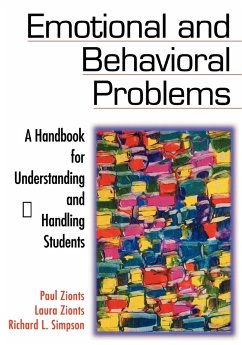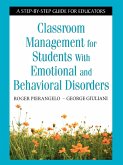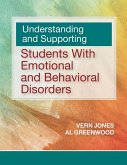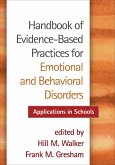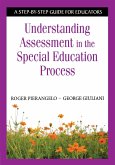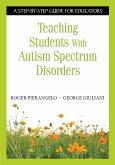Paul Zionts, Central Michigan University, Texas A & M University
Emotional and Behavioral Problems
A Handbook for Understanding and Handling Students
Paul Zionts, Central Michigan University, Texas A & M University
Emotional and Behavioral Problems
A Handbook for Understanding and Handling Students
- Broschiertes Buch
- Merkliste
- Auf die Merkliste
- Bewerten Bewerten
- Teilen
- Produkt teilen
- Produkterinnerung
- Produkterinnerung
`This book is an excellent overview of a very complex area. It is a useful guide to identifying and treating with emotional and behavioural disorders (EBD), and is particularly outstanding on topic related to the educational system and the numerous laws and policies surrounding the education of children who have EBD.This book will serve the field well' - Krista Kutash, Deputy Director and Associate Professor Research and Training Centre for Children's Mental Health, Louis de la Parte Florida Mental Health Institute, Tampa, Florida Emotional and Behavioral Problems is designed to be a resource…mehr
Andere Kunden interessierten sich auch für
![Classroom Management for Students with Emotional and Behavioral Disorders Classroom Management for Students with Emotional and Behavioral Disorders]() Roger PierangeloClassroom Management for Students with Emotional and Behavioral Disorders35,99 €
Roger PierangeloClassroom Management for Students with Emotional and Behavioral Disorders35,99 €![Teaching Students With Emotional Disturbance Teaching Students With Emotional Disturbance]() Bob AlgozzineTeaching Students With Emotional Disturbance29,99 €
Bob AlgozzineTeaching Students With Emotional Disturbance29,99 €![Praxis Special Education: Teaching Students with Behavioral Disorders/Emotional Disturbance 0371 Teacher Certification Test Prep Study Guide Praxis Special Education: Teaching Students with Behavioral Disorders/Emotional Disturbance 0371 Teacher Certification Test Prep Study Guide]() Sharon A. WynnePraxis Special Education: Teaching Students with Behavioral Disorders/Emotional Disturbance 0371 Teacher Certification Test Prep Study Guide22,99 €
Sharon A. WynnePraxis Special Education: Teaching Students with Behavioral Disorders/Emotional Disturbance 0371 Teacher Certification Test Prep Study Guide22,99 €![Understanding and Supporting Students with Emotional and Behavioral Disorders Understanding and Supporting Students with Emotional and Behavioral Disorders]() Vern JonesUnderstanding and Supporting Students with Emotional and Behavioral Disorders83,99 €
Vern JonesUnderstanding and Supporting Students with Emotional and Behavioral Disorders83,99 €![Handbook of Evidence-Based Practices for Emotional and Behavioral Disorders Handbook of Evidence-Based Practices for Emotional and Behavioral Disorders]() Handbook of Evidence-Based Practices for Emotional and Behavioral Disorders79,99 €
Handbook of Evidence-Based Practices for Emotional and Behavioral Disorders79,99 €![Understanding Assessment in the Special Education Process Understanding Assessment in the Special Education Process]() Roger PierangeloUnderstanding Assessment in the Special Education Process33,99 €
Roger PierangeloUnderstanding Assessment in the Special Education Process33,99 €![Teaching Students With Autism Spectrum Disorders Teaching Students With Autism Spectrum Disorders]() Roger PierangeloTeaching Students With Autism Spectrum Disorders42,99 €
Roger PierangeloTeaching Students With Autism Spectrum Disorders42,99 €-
-
-
`This book is an excellent overview of a very complex area. It is a useful guide to identifying and treating with emotional and behavioural disorders (EBD), and is particularly outstanding on topic related to the educational system and the numerous laws and policies surrounding the education of children who have EBD.This book will serve the field well' - Krista Kutash, Deputy Director and Associate Professor Research and Training Centre for Children's Mental Health, Louis de la Parte Florida Mental Health Institute, Tampa, Florida Emotional and Behavioral Problems is designed to be a resource for persons dealing with children and adolescents who have emotional and/or behavioural disabilities. This book is invaluable to professionals dealing with children in all situations as well as to families.The information provided about childhood and adolescent emotional and behavioural problems is both straightforward and basic.
Hinweis: Dieser Artikel kann nur an eine deutsche Lieferadresse ausgeliefert werden.
Hinweis: Dieser Artikel kann nur an eine deutsche Lieferadresse ausgeliefert werden.
Produktdetails
- Produktdetails
- Verlag: Corwin
- Seitenzahl: 256
- Erscheinungstermin: 1. März 2002
- Englisch
- Abmessung: 254mm x 178mm x 14mm
- Gewicht: 489g
- ISBN-13: 9780761977049
- ISBN-10: 076197704X
- Artikelnr.: 21862969
- Herstellerkennzeichnung
- Produktsicherheitsverantwortliche/r
- Europaallee 1
- 36244 Bad Hersfeld
- gpsr@libri.de
- Verlag: Corwin
- Seitenzahl: 256
- Erscheinungstermin: 1. März 2002
- Englisch
- Abmessung: 254mm x 178mm x 14mm
- Gewicht: 489g
- ISBN-13: 9780761977049
- ISBN-10: 076197704X
- Artikelnr.: 21862969
- Herstellerkennzeichnung
- Produktsicherheitsverantwortliche/r
- Europaallee 1
- 36244 Bad Hersfeld
- gpsr@libri.de
Paul Zionts is a professor of special education and Chairperson of the Department of Educational Foundations and Special Services at Kent State University. He has been a teacher in a reform school and an inner-city high school, a program director, consultant, and teacher trainer. He has lectured and provided training in local, state, and national events and has conducted hundreds of workshops that have included teachers, counselors, psycho logists, social workers, administrators, parents, secretaries, and bus drivers. He has authored Teaching Disturbed and Disturbing Students (2nd edition) and Inclusion Strategies for Students with Learning and Behavior Problems, and he has coauthored with Richard Simpson both Autism (2nd edition) and Understanding Children and Youth with Emotional and Behavioral Problems.
Preface
Acknowledgments
About the Authors
Part One: Understanding Emotional and Behavioral Disorders
1: Introduction to Emotional Disturbance and Behavioral Disorders
By Any Other Name: Emotional and Behavioral Disorders
Possible Causes of Emotional Disturbance and Behavioral Disorders
Incidence
Serious Emotional Disturbance or Behavioral Disorders or EBD: What¿s the
Difference?
How Professionals View Labels
Identification of EBD
Behaviors That Fit Into Educational Stages
Characteristics of Emotionally Disturbed or Behaviorally Disordered
Children and Youth
Summary
2. Major Types of Emotional and Behavioral Disorders
Externalizing Behaviors
Internalizing Behaviors
Function Disorders
Summary
3. Causes of Emotional and Behavioral Disorders
Understanding Factors Related to the Development of EBD
Understanding Potential Causes of EBD
Summary
4. Evaluating and Assessing Students Who Have Emotional and Behavioral
Disorders - Laura Zionts & Katherine deGeorge
The Purpose of Evaluation
An Overview of EBD Evaluation
Specific Aspects of the Evaluation Process as They Relate to EBD
Evaluation Techniques Used to Determine Eligibility
Summary
5. Violence and Aggression in Schools - Sara Sibilsky, Paul Zionts
Violence and Aggression in the Schools
The Roots of Violent and Aggressive Behaviors in Children and Adolescents
Violence, Aggression, and EBD
Responses to School Violence and Aggression
Reducing and Preventing Violence and Aggression
Summary
6. Adolescents Who Have Emotional and Behavioral Disorders and the Juvenile
Justice System
Background Information on EBD and the Juvenile Justice System
Perplexing Issues of Ethnicity, Mental Health, and Juvenile Justice in the
United States
Addressing Issues of Ethnicity and Bias in Juvenile Justice Agencies
Addressing the Mental Health Needs of All Youth in the Juvenile Justice
System
Special Education and the Juvenile Justice System
Juvenile Justice and Youth Who Have EBD: Intervention and Reintegration
Strategies
Summary
Part Two: Helping Students Who Have Emotional and Behavioral Disorders
7. Treatment of Emotional and Behavioral Disorders
Behavior Modification
Examples of Two Behavior Modification Programs
Schoolwide Discipline: Positive Behavioral Supports
Cognitive Behavior Therapy
Summary
8. School-Based Placements
After Identification
Determining Appropriate Educational Goals
The Least Restrictive Environment
The Continuum of Services: Placement Options
An Important Caveat About Placements
Possible Parental Reactions to Placement Options
Changing Placements Because of Behavior
A Few Words About Inclusion
Summary
9. Supporting Students With Emotional and Behavioral Disorders Outside the
Public School Setting
Medications for Emotional and Behavioral Disorders: Psychopharmacology
The Role of Psychiatric and Juvenile Justice Professionals on the IEP Team
Collaborative Efforts Between Mental Health Agencies and the Educational
System
Systems of Care
Insurance, Managed Care, Medicare, and Systems of Care
Summary
10. The Role of Families in Supporting Children With Emotional and
Behavioral Concerns - Karen Anhalt, Richard Simpson, Laura Zionts
Parents as Referral Agents
Teachers as Referral Agents
Parents as Advocates for Their Children With Emotional and Behavioral
Concerns
The Importance of Being a Support Agent
Implementing Changes at Home
Exercises for Improving Communication
Ideas to Improve Discipline Strategies at Home
Finding Ways to Relieve Stress
Summary
11. What Lies Ahead: Postschool Transition
Critical Concepts About EBD
Postschool Success
Transition Planning
Summary
Resources for Professionals and Parents - Laura Zionts, Katherine deGeorge
Index
Acknowledgments
About the Authors
Part One: Understanding Emotional and Behavioral Disorders
1: Introduction to Emotional Disturbance and Behavioral Disorders
By Any Other Name: Emotional and Behavioral Disorders
Possible Causes of Emotional Disturbance and Behavioral Disorders
Incidence
Serious Emotional Disturbance or Behavioral Disorders or EBD: What¿s the
Difference?
How Professionals View Labels
Identification of EBD
Behaviors That Fit Into Educational Stages
Characteristics of Emotionally Disturbed or Behaviorally Disordered
Children and Youth
Summary
2. Major Types of Emotional and Behavioral Disorders
Externalizing Behaviors
Internalizing Behaviors
Function Disorders
Summary
3. Causes of Emotional and Behavioral Disorders
Understanding Factors Related to the Development of EBD
Understanding Potential Causes of EBD
Summary
4. Evaluating and Assessing Students Who Have Emotional and Behavioral
Disorders - Laura Zionts & Katherine deGeorge
The Purpose of Evaluation
An Overview of EBD Evaluation
Specific Aspects of the Evaluation Process as They Relate to EBD
Evaluation Techniques Used to Determine Eligibility
Summary
5. Violence and Aggression in Schools - Sara Sibilsky, Paul Zionts
Violence and Aggression in the Schools
The Roots of Violent and Aggressive Behaviors in Children and Adolescents
Violence, Aggression, and EBD
Responses to School Violence and Aggression
Reducing and Preventing Violence and Aggression
Summary
6. Adolescents Who Have Emotional and Behavioral Disorders and the Juvenile
Justice System
Background Information on EBD and the Juvenile Justice System
Perplexing Issues of Ethnicity, Mental Health, and Juvenile Justice in the
United States
Addressing Issues of Ethnicity and Bias in Juvenile Justice Agencies
Addressing the Mental Health Needs of All Youth in the Juvenile Justice
System
Special Education and the Juvenile Justice System
Juvenile Justice and Youth Who Have EBD: Intervention and Reintegration
Strategies
Summary
Part Two: Helping Students Who Have Emotional and Behavioral Disorders
7. Treatment of Emotional and Behavioral Disorders
Behavior Modification
Examples of Two Behavior Modification Programs
Schoolwide Discipline: Positive Behavioral Supports
Cognitive Behavior Therapy
Summary
8. School-Based Placements
After Identification
Determining Appropriate Educational Goals
The Least Restrictive Environment
The Continuum of Services: Placement Options
An Important Caveat About Placements
Possible Parental Reactions to Placement Options
Changing Placements Because of Behavior
A Few Words About Inclusion
Summary
9. Supporting Students With Emotional and Behavioral Disorders Outside the
Public School Setting
Medications for Emotional and Behavioral Disorders: Psychopharmacology
The Role of Psychiatric and Juvenile Justice Professionals on the IEP Team
Collaborative Efforts Between Mental Health Agencies and the Educational
System
Systems of Care
Insurance, Managed Care, Medicare, and Systems of Care
Summary
10. The Role of Families in Supporting Children With Emotional and
Behavioral Concerns - Karen Anhalt, Richard Simpson, Laura Zionts
Parents as Referral Agents
Teachers as Referral Agents
Parents as Advocates for Their Children With Emotional and Behavioral
Concerns
The Importance of Being a Support Agent
Implementing Changes at Home
Exercises for Improving Communication
Ideas to Improve Discipline Strategies at Home
Finding Ways to Relieve Stress
Summary
11. What Lies Ahead: Postschool Transition
Critical Concepts About EBD
Postschool Success
Transition Planning
Summary
Resources for Professionals and Parents - Laura Zionts, Katherine deGeorge
Index
Preface
Acknowledgments
About the Authors
Part One: Understanding Emotional and Behavioral Disorders
1: Introduction to Emotional Disturbance and Behavioral Disorders
By Any Other Name: Emotional and Behavioral Disorders
Possible Causes of Emotional Disturbance and Behavioral Disorders
Incidence
Serious Emotional Disturbance or Behavioral Disorders or EBD: What¿s the
Difference?
How Professionals View Labels
Identification of EBD
Behaviors That Fit Into Educational Stages
Characteristics of Emotionally Disturbed or Behaviorally Disordered
Children and Youth
Summary
2. Major Types of Emotional and Behavioral Disorders
Externalizing Behaviors
Internalizing Behaviors
Function Disorders
Summary
3. Causes of Emotional and Behavioral Disorders
Understanding Factors Related to the Development of EBD
Understanding Potential Causes of EBD
Summary
4. Evaluating and Assessing Students Who Have Emotional and Behavioral
Disorders - Laura Zionts & Katherine deGeorge
The Purpose of Evaluation
An Overview of EBD Evaluation
Specific Aspects of the Evaluation Process as They Relate to EBD
Evaluation Techniques Used to Determine Eligibility
Summary
5. Violence and Aggression in Schools - Sara Sibilsky, Paul Zionts
Violence and Aggression in the Schools
The Roots of Violent and Aggressive Behaviors in Children and Adolescents
Violence, Aggression, and EBD
Responses to School Violence and Aggression
Reducing and Preventing Violence and Aggression
Summary
6. Adolescents Who Have Emotional and Behavioral Disorders and the Juvenile
Justice System
Background Information on EBD and the Juvenile Justice System
Perplexing Issues of Ethnicity, Mental Health, and Juvenile Justice in the
United States
Addressing Issues of Ethnicity and Bias in Juvenile Justice Agencies
Addressing the Mental Health Needs of All Youth in the Juvenile Justice
System
Special Education and the Juvenile Justice System
Juvenile Justice and Youth Who Have EBD: Intervention and Reintegration
Strategies
Summary
Part Two: Helping Students Who Have Emotional and Behavioral Disorders
7. Treatment of Emotional and Behavioral Disorders
Behavior Modification
Examples of Two Behavior Modification Programs
Schoolwide Discipline: Positive Behavioral Supports
Cognitive Behavior Therapy
Summary
8. School-Based Placements
After Identification
Determining Appropriate Educational Goals
The Least Restrictive Environment
The Continuum of Services: Placement Options
An Important Caveat About Placements
Possible Parental Reactions to Placement Options
Changing Placements Because of Behavior
A Few Words About Inclusion
Summary
9. Supporting Students With Emotional and Behavioral Disorders Outside the
Public School Setting
Medications for Emotional and Behavioral Disorders: Psychopharmacology
The Role of Psychiatric and Juvenile Justice Professionals on the IEP Team
Collaborative Efforts Between Mental Health Agencies and the Educational
System
Systems of Care
Insurance, Managed Care, Medicare, and Systems of Care
Summary
10. The Role of Families in Supporting Children With Emotional and
Behavioral Concerns - Karen Anhalt, Richard Simpson, Laura Zionts
Parents as Referral Agents
Teachers as Referral Agents
Parents as Advocates for Their Children With Emotional and Behavioral
Concerns
The Importance of Being a Support Agent
Implementing Changes at Home
Exercises for Improving Communication
Ideas to Improve Discipline Strategies at Home
Finding Ways to Relieve Stress
Summary
11. What Lies Ahead: Postschool Transition
Critical Concepts About EBD
Postschool Success
Transition Planning
Summary
Resources for Professionals and Parents - Laura Zionts, Katherine deGeorge
Index
Acknowledgments
About the Authors
Part One: Understanding Emotional and Behavioral Disorders
1: Introduction to Emotional Disturbance and Behavioral Disorders
By Any Other Name: Emotional and Behavioral Disorders
Possible Causes of Emotional Disturbance and Behavioral Disorders
Incidence
Serious Emotional Disturbance or Behavioral Disorders or EBD: What¿s the
Difference?
How Professionals View Labels
Identification of EBD
Behaviors That Fit Into Educational Stages
Characteristics of Emotionally Disturbed or Behaviorally Disordered
Children and Youth
Summary
2. Major Types of Emotional and Behavioral Disorders
Externalizing Behaviors
Internalizing Behaviors
Function Disorders
Summary
3. Causes of Emotional and Behavioral Disorders
Understanding Factors Related to the Development of EBD
Understanding Potential Causes of EBD
Summary
4. Evaluating and Assessing Students Who Have Emotional and Behavioral
Disorders - Laura Zionts & Katherine deGeorge
The Purpose of Evaluation
An Overview of EBD Evaluation
Specific Aspects of the Evaluation Process as They Relate to EBD
Evaluation Techniques Used to Determine Eligibility
Summary
5. Violence and Aggression in Schools - Sara Sibilsky, Paul Zionts
Violence and Aggression in the Schools
The Roots of Violent and Aggressive Behaviors in Children and Adolescents
Violence, Aggression, and EBD
Responses to School Violence and Aggression
Reducing and Preventing Violence and Aggression
Summary
6. Adolescents Who Have Emotional and Behavioral Disorders and the Juvenile
Justice System
Background Information on EBD and the Juvenile Justice System
Perplexing Issues of Ethnicity, Mental Health, and Juvenile Justice in the
United States
Addressing Issues of Ethnicity and Bias in Juvenile Justice Agencies
Addressing the Mental Health Needs of All Youth in the Juvenile Justice
System
Special Education and the Juvenile Justice System
Juvenile Justice and Youth Who Have EBD: Intervention and Reintegration
Strategies
Summary
Part Two: Helping Students Who Have Emotional and Behavioral Disorders
7. Treatment of Emotional and Behavioral Disorders
Behavior Modification
Examples of Two Behavior Modification Programs
Schoolwide Discipline: Positive Behavioral Supports
Cognitive Behavior Therapy
Summary
8. School-Based Placements
After Identification
Determining Appropriate Educational Goals
The Least Restrictive Environment
The Continuum of Services: Placement Options
An Important Caveat About Placements
Possible Parental Reactions to Placement Options
Changing Placements Because of Behavior
A Few Words About Inclusion
Summary
9. Supporting Students With Emotional and Behavioral Disorders Outside the
Public School Setting
Medications for Emotional and Behavioral Disorders: Psychopharmacology
The Role of Psychiatric and Juvenile Justice Professionals on the IEP Team
Collaborative Efforts Between Mental Health Agencies and the Educational
System
Systems of Care
Insurance, Managed Care, Medicare, and Systems of Care
Summary
10. The Role of Families in Supporting Children With Emotional and
Behavioral Concerns - Karen Anhalt, Richard Simpson, Laura Zionts
Parents as Referral Agents
Teachers as Referral Agents
Parents as Advocates for Their Children With Emotional and Behavioral
Concerns
The Importance of Being a Support Agent
Implementing Changes at Home
Exercises for Improving Communication
Ideas to Improve Discipline Strategies at Home
Finding Ways to Relieve Stress
Summary
11. What Lies Ahead: Postschool Transition
Critical Concepts About EBD
Postschool Success
Transition Planning
Summary
Resources for Professionals and Parents - Laura Zionts, Katherine deGeorge
Index

